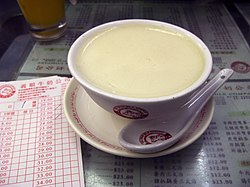Ginger milk curd: Difference between revisions
No edit summary |
Chris Mounce (talk | contribs) m Undid revision 691276192 by 38.107.226.165 (talk) |
||
| Line 1: | Line 1: | ||
{{refimprove|date=March 2013}} |
{{refimprove|date=March 2013}} |
||
{{Infobox prepared food |
{{Infobox prepared food |
||
| name = |
| name = Ginger milk curd |
||
| image = [[File:Ginger Milk Pudding.jpg|250px]] |
| image = [[File:Ginger Milk Pudding.jpg|250px]] |
||
| caption = |
| caption = |
||
Revision as of 05:21, 28 November 2015
This article needs additional citations for verification. (March 2013) |
 | |
| Alternative names | Ginger-juice milk curd, ginger milk pudding, ginger milk |
|---|---|
| Type | Pastry |
| Course | Dessert |
| Place of origin | China |
| Region or state | Guangzhou |
| Main ingredients | Ginger, milk, sugar |
| Ginger milk curd | |||||||||||
|---|---|---|---|---|---|---|---|---|---|---|---|
| Traditional Chinese | |||||||||||
| Simplified Chinese | |||||||||||
| Literal meaning | Ginger collides with milk | ||||||||||
| |||||||||||
Ginger milk curd, also known as ginger-juice milk curd, ginger milk pudding or simply ginger milk, is a Chinese hot dessert originated in Shawan town of Panyu District, Guangzhou in the Guangdong Province in southern China. The main ingredients are ginger, milk, and sugar.[1] Water buffalo milk is used in the original recipe.
Method of preparation
First, cut a piece of old ginger into small pieces and grind the ginger to fine. Then, squeeze the juice out by pressing the ginger through a sieve. Put the juice into a bowl. Next, bring the milk to a boil and dissolve sugar in milk. Take off heat and allow it to cool a little. If you have a kitchen thermometer, place your kitchen thermometer into the milk. The optimum curdling temperature is 70°C.[2] In the mean time, stir the ginger juice thoroughly. When milk temperature decreases to around 75-70°C, pour the milk quickly into the middle of the ginger juice. Wait for two to three minutes. The milk will then be curdled, and may be eaten with a spoon.
Underlying biochemical principle
Ginger contains the protease zingipain. When milk is added to ginger juice, this protease catalyses denaturation of the protein in the milk, changing it from a water-soluble form to a water-insoluble form, and leads to the formation of milk curd.
See also
References
- ^ "Ginger Milk Pudding, a Natural Custard". tastehongkong.com. 29 March 2011. Retrieved 13 August 2012.
- ^ "Ginger Milk Pudding". marecipes.com. Retrieved 19 June 2015.
External links
